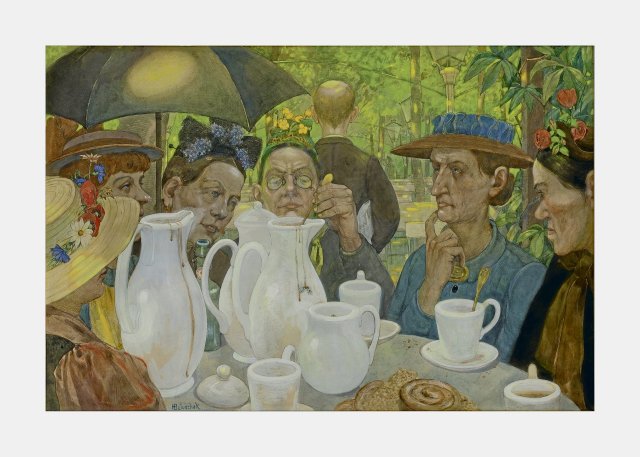The coffee spoon as a magic wand: “Families can make coffee here”, oil on canvas, 1895
Foto: Copyright: Rainer Jordan
He is considered a socially critical chronicler of the city of Berlin. In addition to scenes from Berlin’s popular life, he dedicated himself to depicting misery, motifs of disillusionment and the massification of people in the factories, on the streets, in public and in homes. Humor and cheerfulness, but also mockery, scorn or contempt can hardly be found here. Depression and desolation prevail.
Now the Bröhan Museum in Berlin is using selected examples to show how Hans Baluschek assigned “secret codes” to many of his pictures, so that another story appears hidden behind his story. He was no stranger to playing with the ambiguous. “Families can make coffee here” (1895) – Baluschek took up this popular saying and transformed it into a cartoonish snapshot: This is not a cozy coffee chat, it shows the lower middle class milieu of dressed-up coffee aunts. The women sit behind the huge jugs with tired, expressionless faces, unable to shed the burden of everyday life. But is that all? Now new interpretations are based on a witch’s coven that takes place at the round table, a symbol of a magic circle. A woman with pince-nez, the sorceress, stirs a magic potion in the pot with a spoon that replaces the magic wand, while flies on the pots seem to convey occult messages.
Two of Baluschek’s major works, “Rummelplatz” (1914) and “Big City Lights” (1933), prove to be a prophetic warning of approaching catastrophes, showing Berlin between a folk festival and mobilization. The stream of pedestrians, which splits left and right in the second picture, assigns some to the proletariat and others to the bourgeoisie. In contrast, in the picture “Ein Toter (Dead on the Country Road)” (1922), the corpse of a vagabond appears with his arms outstretched in the pose of the Messiah.
The residents of the desolate tenements behind them spend the “summer evening” (1928) in the barren field in the foreground. But could one have suspected that the painter was depicting the seven virtues and deadly sins in pairs and groups? There are existential questions in the circle of life from which his motives also emerge. Baluschek’s visual world – as this museum reassessment proves – is more profound than previously assumed, more imaginative and of greater creativity. It will now also be viewed in the border area between dream and reality, the unconscious and the conscious. With his proximity to the mysterious and hidden, the painter of social pity also aims at irritation and a subversive effect in order to stimulate new thinking.
»Secret codes. Rereading Hans Baluschek’s paintings!”, until September 1st, Bröhan Museum, Berlin
judi bola link sbobet sbobet link sbobet
